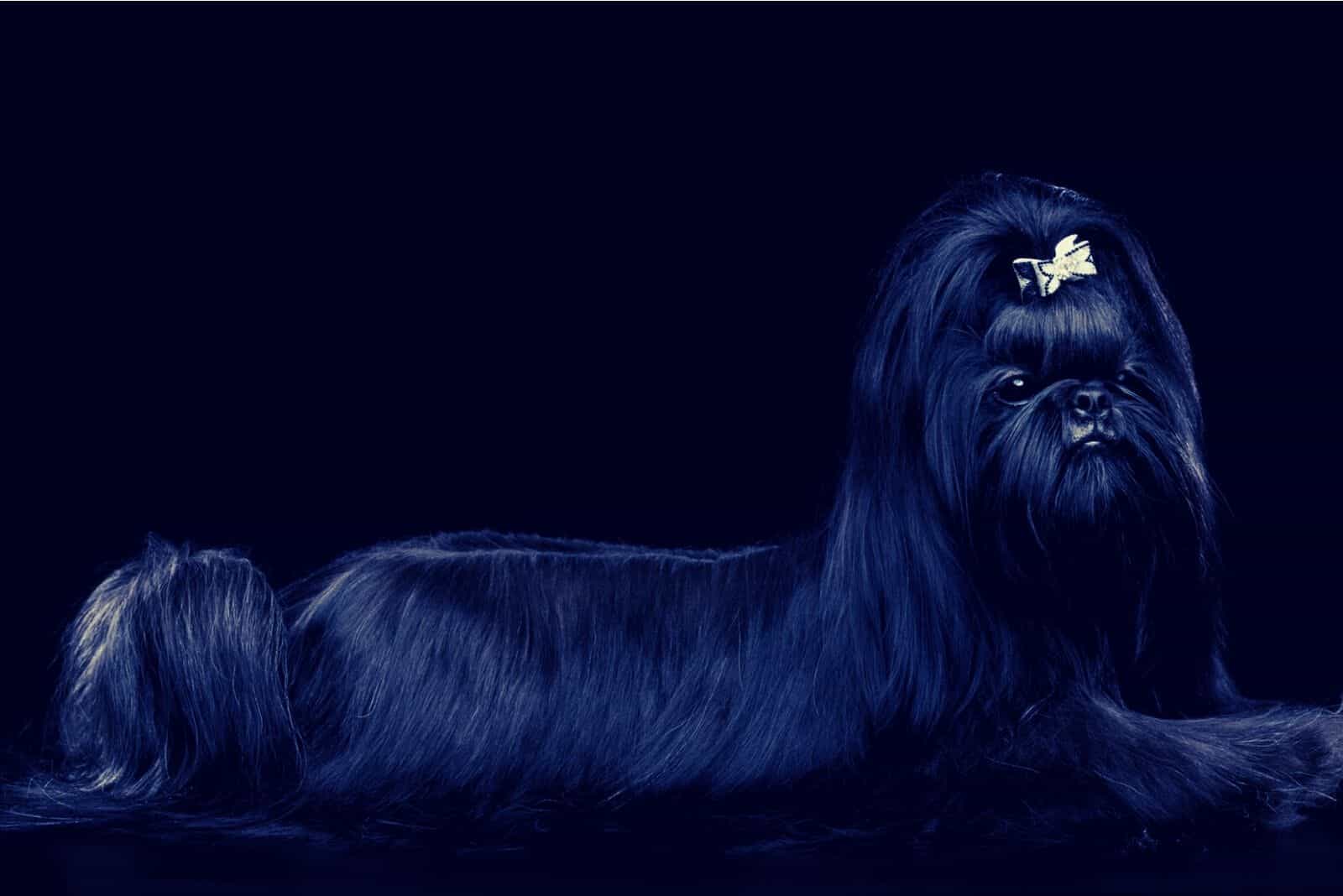Shih Tzus are dogs that can come in plenty of coat colors. This fascinates many aspiring buyers as they might end up spending hours looking at images of Shih Tzus in all the different colors.
This variety of colors can also help breeders differentiate as some might specialize in one Shih Tzu color trying to perfect it.
Most kennel clubs are encouraging breeding these little dogs in all sorts of patterns and shades. According to the American Kennel Club (AKC), all fur colors are permissible for the Shih Tzu breed.
The same goes for the United Kennel Club (UKC), which agrees on this, and even states a few markings that are deemed the most desirable on parti-colored Shih Tzus. The Federation Cynologique Internationale (FCI) also agrees on this.
Even the Canadian Kennel Club states that Shih Tzus can come in any color as long as they have black lips, noses, and eye rims.
As you can see, there are many possibilities when it comes to the Shih Tzu breed. So, which one will you choose?
While it’s hard to say which coat color is the most popular since trends tend to change, one thing is certain – there is something special about blue Shih Tzus.
To help you out, we’ll explain most Shih Tzu colors and patterns. However, our focus will remain on this gorgeous coat color as blue Shih Tzus truly stand out from the rest.
Let’s get started.
Standard Vs. Non-Standard Coat Colors
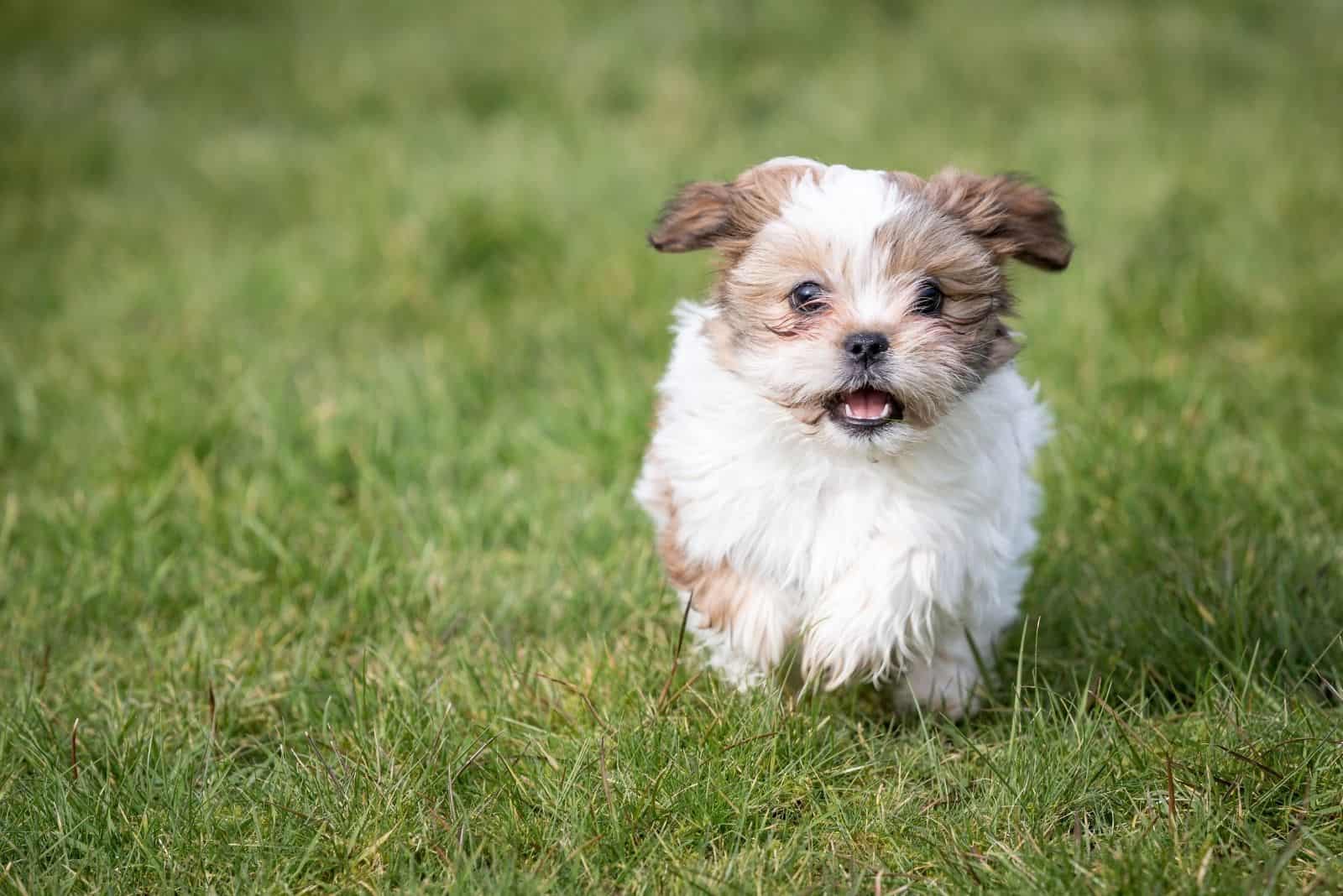
If you’re looking for your new Shih Tzu puppy, you may have noticed many breeders selling dogs in colors that you won’t find on lists approved by the kennel clubs. This, however, doesn’t mean that the dogs aren’t registered.
Some breeders use this type of color labeling to further describe the exact shade of the coat. Others may simply use it to help them sell their puppies for a higher price. Whichever the case, the result stays the same.
For example, you might see dogs being advertised as having a lavender, a chocolate, or an isabella coat color. None of these are considered to be a standard color. If the Shih Tzu breeder was to register some of these puppies, they’d do so under the ‘liver’ label.
So far, the standard colors are:
• Black
• White
• Silver
• Gold
• Red
• Liver
• Brindle
• Blue
As you can see, the blue coat color falls in the standard color category.
To make everything clearer, we will give a brief explanation of all the colors before we focus on today’s favorite – the blue Shih Tzu.
What Is The Rarest Colored Shih Tzu?
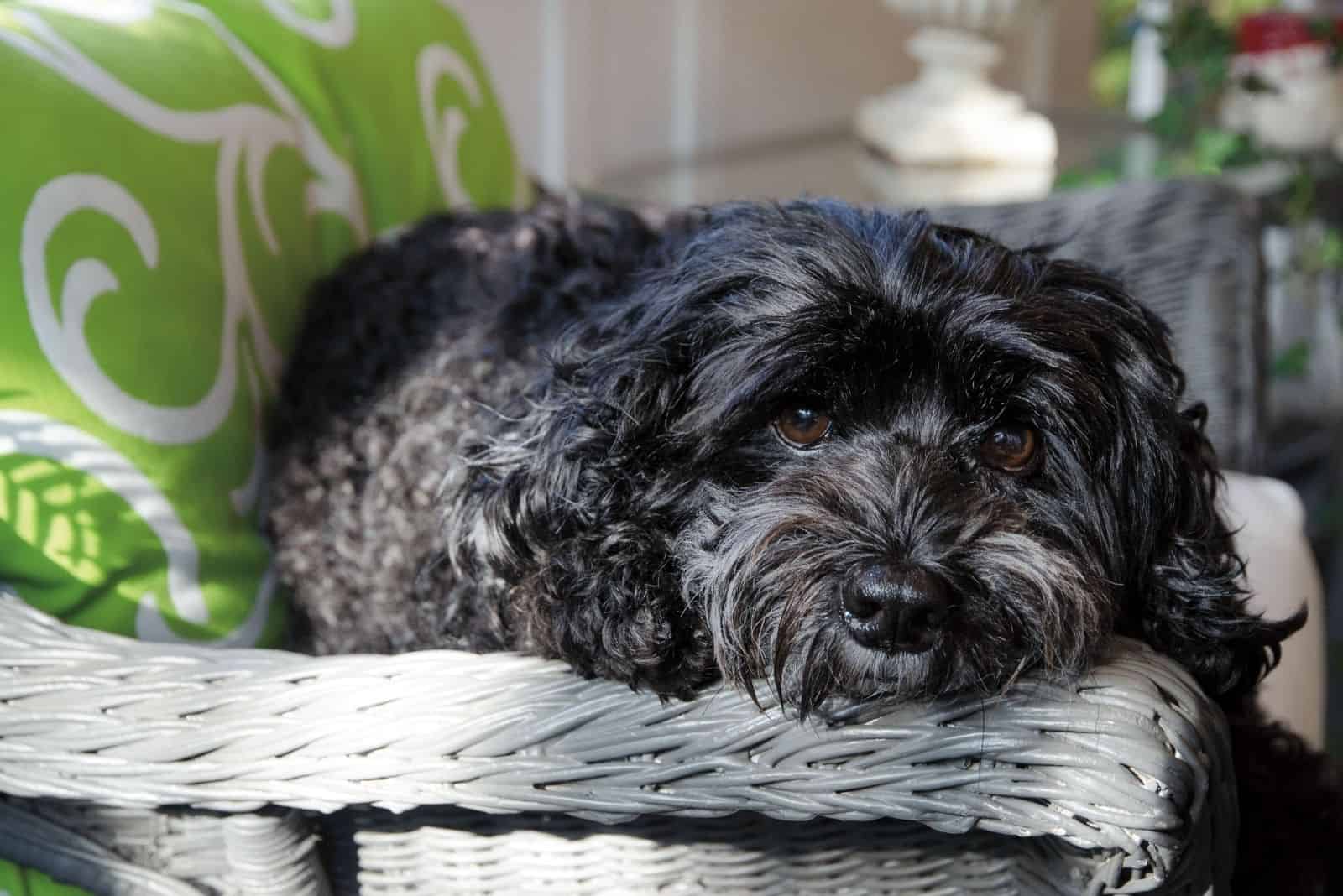
Rare colors have always been sought after, no matter the dog breed. The same goes even for the most colorful of dogs, such as Shih Tzus.
Some standard colors, such as white, silver, or red, are quite common. Others, such as blue or black, are not so common.
Keep in mind that just because some color isn’t standard doesn’t immediately make it rare, and vice versa. This only means that you can recognize a dog as a certain color, and it speaks nothing about how common the color is.
Standard Shih Tzu Coat Colors
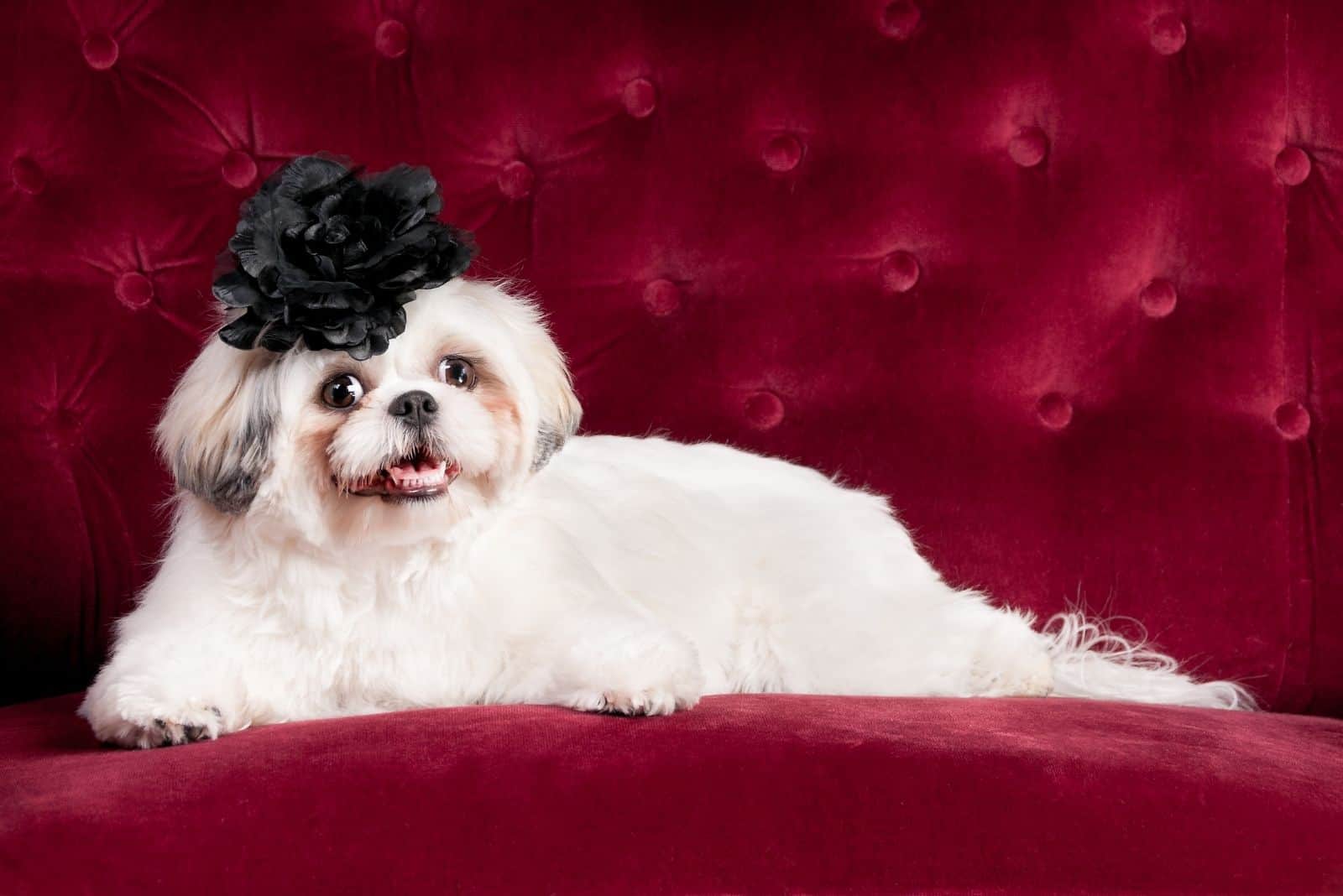
There are several standard coat colors, and all of them can come in plenty of different color combinations – usually, you can see bicolor dogs with parti or tuxedo markings, but there are also brindle, sable, and other combinations.
Here’s what they are:
Black Shih Tzu
Black is the most dominant color, and a true black Shih Tzu will have only this color on its fur. All black Shih Tzus will also have black noses, eye rims, and foot pads.
Also, a black Shih Tzu can never have a brown or a pink nose as the black pigment covers more than just fur.
Black Shih Tzus come in plenty of color combinations. If a dog has just a speck of another color, it cannot be considered a solid colored Shih Tzu. Still, you can have a black and tan Shih Tzu, a black and white Shih Tzu, and so on.
White Shih Tzu
A white coat is actually the result of a lack of pigment. However, this is different from many other solid colors of Shih Tzus as the nose and paw pads of these dogs aren’t white or pink, but black.
If you want to register your cream dog with the AKC, you might be surprised that they’ll only allow you to do so if you agree that the dog will be labeled as ‘white’. The same goes for most coat colors that aren’t entirely white but have some darker shade.
Finding a solid colored white Shih Tzu isn’t as difficult as finding a solid colored black one.
At the same time, these pups come in several coat combinations, such as white and black, white and tan, tuxedo, and so on. White patches are also the most common type of pattern on dogs of all other fur colors.
Silver Shih Tzu
This is one of the few bright coat colors that won’t be labeled as white.
The silver coat color has a deep shine that resembles silver. It isn’t gray, but rather white with a significant shine to it.
Just like white Shih Tzus, these dogs will have black noses, eye rims, and paw pads.
Red Shih Tzu
Red coat color gives dogs a deep, dark, orangy look. These dogs might look ginger, reddish-brown, or even pure red!
Red comes in plenty of shades and patterns, including tuxedo, parti, and even sable and brindle! It can also come in a variety of shades, but all will be dark and warm.
Red Shih Tzus have black eye rims, lips, noses, and foot pads. This is what differentiates them from brown Shih Tzus.
Gold Shih Tzu
Gold Shih Tzus can look anywhere between tan and bright yellow. Many of them have black masks or black ears, but some can come in pure gold color.
These dogs share a common color of their nose with the other coat shades we’ve mentioned. This means that their nose, feet pads, and so on are black in color.
They can also come in tuxedo, brindle, sable, or a parti pattern, but these are a bit rarer than just a standard black mask.

Photo from @canilbrpeppers
Liver Shih Tzu
Liver dogs come in three different colors, but all of them fall under the liver spectrum. Their coat color can be brown, red, or even white, but all of them will have a brown nose, eye rims, paw pads, and lips.
In other words, these pups can come in many warm-colored shades, but it isn’t the coat color that’s causing them to be considered liver, rather, the rest of their pigmentation.
Liver color can be a bit confusing as it’s actually manifested by the lack of black pigment. This means that they cannot have black fur or skin pigmentation. If they do, they cannot be considered liver, but rather red or diluted black.
As these pups don’t have black pigment, they don’t necessarily have brown eyes. In fact, some might come with green eyes! This is rare, though.
The liver gene is recessive, meaning that both dog parents have to carry it (even though they don’t necessarily have to be liver themselves) for the puppy to be liver colored.
Brindle
When people think of dogs with a brindle coat, they likely think about Pitbulls.
This is a recessive gene that, despite this, isn’t too rare, but it isn’t as noticeable in Shih Tzus as it is in some other dog breeds.
Brindle is, in fact, a pattern that resembles tiger stripes. These stripes can vary greatly in thickness and appearance, so no two brindle dogs are truly alike.
Depending on the base coat color, a dog can be considered to be blue brindle, black brindle, white brindle, and so on. Some dogs even have brindle patches, and they’re not entirely in this pattern.
Because Shih Tzus have a long coat, the brindle pattern won’t be as obvious on them as it would be in some other dog breeds. These pups might simply appear to have patches of darker and lighter skin in a somewhat regular pattern.
Keep in mind that these dogs can experience a color change as they grow older. Many Shih Tzu puppies have a brindle coat that can turn into something entirely different once they mature.
Also, plenty of brindle Shih Tzus have a black mask over their muzzles as is common with short-haired brindle breeds. They also have black noses, eye rims, lips, and paw pads.
Blue Line Shih Tzu
Finally, we have blue Shih Tzu dogs. This color is quite rare in this dog breed, and it’s hard to determine whether a dog is blue coated or not based on pictures alone. If you’re talking to a Shih Tzu breeder, ask him to see the dog in person and observe him in the sunlight.
A genuine blue Shih Tzu can have several coat colors, but it will always have a blue nose. In fact, its fur shade will usually resemble gray or charcoal, and the blue can be difficult to observe except in bright natural light.
Speaking of genetics, blue is the result of a dilution gene. In fact, it isn’t considered a color, but a dilute.
This occurs when the black or brown pigment has been affected by the said dilution gene. This causes the original pigment to be distributed irregularly and clumped differently.
If the color is brown, then the end color will be isabella or lilac; a light silvery color. Some Shih Tzu breeders call this lavender.
However, if the base color is black, then the dog will be in the recognizable blue shade that will express itself on the dog’s skin the most.
While the AKC recognizes blue Shih Tzus, it doesn’t recognize isabella or lilac ones. This means that you either won’t be able to register these dogs, or you’ll have to register them under some different color, such as white.
The dilution gene that causes dogs to be blue doesn’t have to affect their coat color. However, it will always affect their nose, lips, and other points. This is why, just as with liver, you can find these pups in several coat colors, which is why they’re known as the ‘blue line’.
So, if you want a blue Shih Tzu, you should keep in mind that the nose is the true indication (and the easiest one to notice) of whether a dog is blue or not.
Blue Shih Tzu Colors
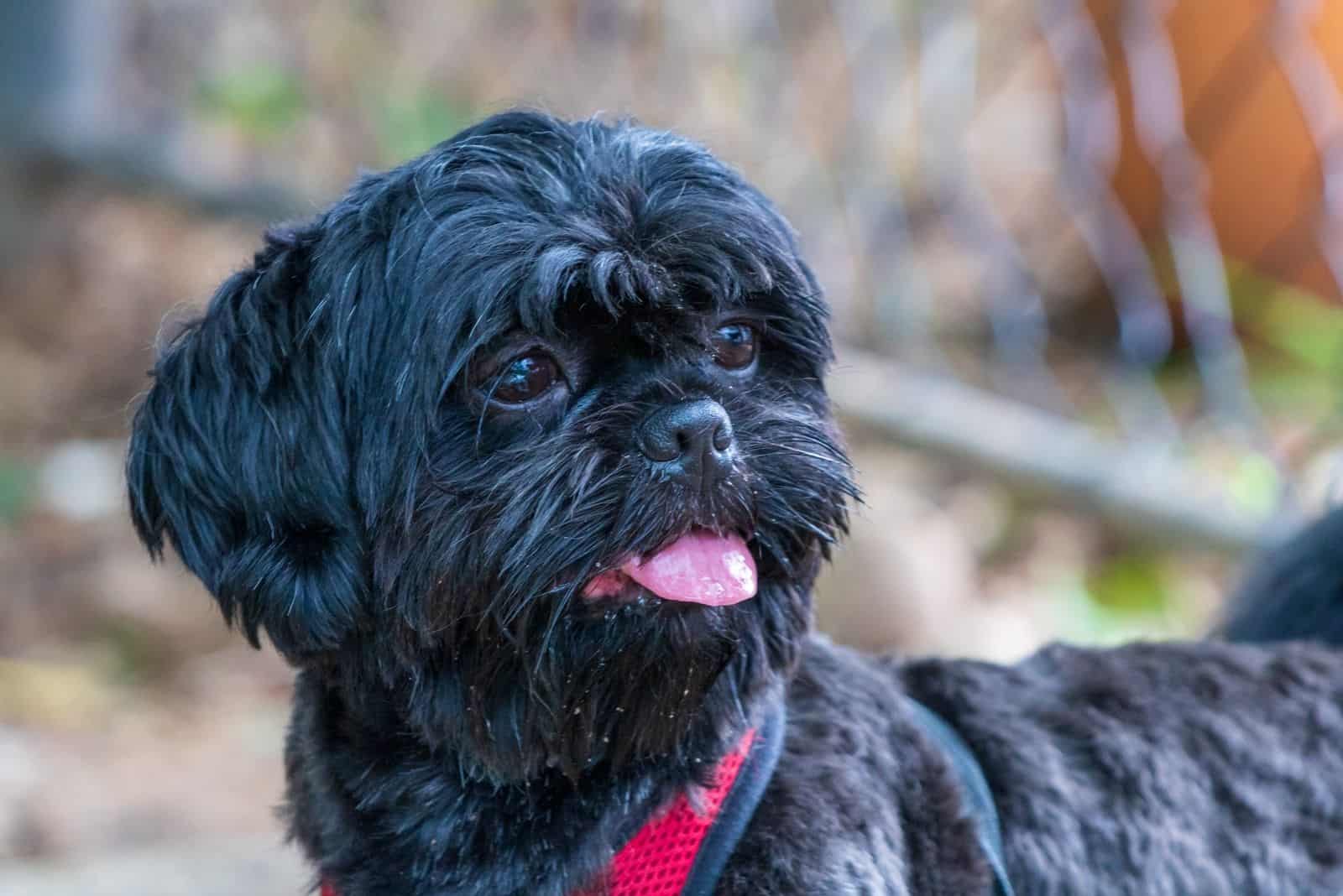
As we’ve mentioned, blue Shih Tzus don’t have to have a blue coat. In fact, most will have gray to silver fur that will match the color of their nose. However, this doesn’t mean that all gray-coated dogs are blue dogs.
Also, not all blue Shih Tzus are solid colored. Many have patterns and are bicolor, just as is the case with most coat colors in Shih Tzus.
Here are some of the patterns and variations when it comes to blue Shih Tzus:
Blue Brindle Shih Tzu
Blue brindle Shih Tzus are brindle dogs with blue noses. They’ll usually have a blue base coat, but this is not mandatory. A true blue Shih Tzu will always have a blue nose and other visible skin parts.
While it might appear that these pups have black stripes on gray fur, they aren’t likely to have an actual black color on their coat. This is because only a black dog can have black pigmentation. However, these stripes can be so dark that they’ll look almost pure black.
If you have a Shih Tzu with a gray brindle, look at his nose color. If it’s dark gray or blue, you have a blue Shih Tzu. Otherwise, the dog simply has a regular brindle pattern.
Keep in mind that many puppies have a brindle coat color when they’re young. Once they grow older, the brindle will disappear, and the dog will reach its true shade.
Blue Cream Shih Tzu
A blue cream Shih Tzu is actually a common occurrence. This doesn’t mean that a dog is bicolor – although it will most likely have some white markings. It simply means that your dog has a coat that appears to be cream, with a blue nose, eye rims, and foot pads.
Some dog breeders might even say that these dogs have a mocha fur color as it can have the shade of a cafe latte.
If a dog has a cream coat color or any pattern with cream as a base color, look at his nose. This is the best way to see whether you have a blue cream, a liver cream, or a white cream Shih Tzu.
Blue And Tan Shih Tzu
This is a fairly common color combination for Shih Tzus. Tan markings are the usual sight on a black dog, and the presence of the dilution gene only turns the black into blue.
These markings can appear on various parts of a Shih Tzu’s body. They can come in parti, tuxedo, and even spotted!
If you’re looking for a blue Shih Tzu puppy, you’ll most likely find a dog with these markings because they are very common.
Blue Dobie Shih Tzu
A Blue Dobie Shih Tzu is a very rare type of dog. These pups have tan markings in a specific pattern on certain locations of the dog’s body – a spot right above both eyes, on the jowls, under the tail, and on the lower legs.
These markings usually appear on dogs with black hair, and they are very rare on liver dogs. With the work of the dilution gene, you can get a blue Shih Tzu with a Dobie pattern.
Blue Shih Tzus with Dobie markings will usually be registered as blue and tan as there isn’t a specific category for this pattern.
Blue Gray Shih Tzu
Blue gray Shih Tzus are blue Shih Tzus with a gray coat color. This is one of the most common types of blue Shih Tzus.
The gray color is usually a form of diluted black color, which is precisely why it’s so common in blue Shih Tzus. These dogs will have a blue or a gray nose, and the biggest part of their body will be gray.
They can be solid colored, but most will have a brindle pattern or white markings.
Silver Blue Shih Tzu
While not as common as the gray color, sometimes silver can be the result of the dilution gene on the black coat. These dogs will look light gray or even white, but with a more or less noticeable silver shine on their coat.
Silver and light gray dogs can easily get confusing, and it can be hard to determine the difference between them. However, the coat of most gray dogs will appear almost dull while silver dogs have that shine.
To understand if a silver dog is actually black or blue, you should check out his nose. If it’s blue, then your dog is a blue Shih Tzu.
Lavender Blue Shih Tzu
Although most lavender Shih Tzus are liver dogs, they can sometimes be blue as well. This is the result of an unusual gene combination that can happen when a red Shih Tzu happens to also have the dilution gene.
As the dog’s primary pigment was eumelanin, the dog will still be considered blue – in the end, its nose, eye rims, and other visible body parts will be blue or gray. However, its red fur won’t fade to the blue color, but rather isabella or lilac.
These pups often come with white markings, and finding a solid color lavender blue Shih Tzu can be a tricky task.
A Blue-Eyed Shih Tzu
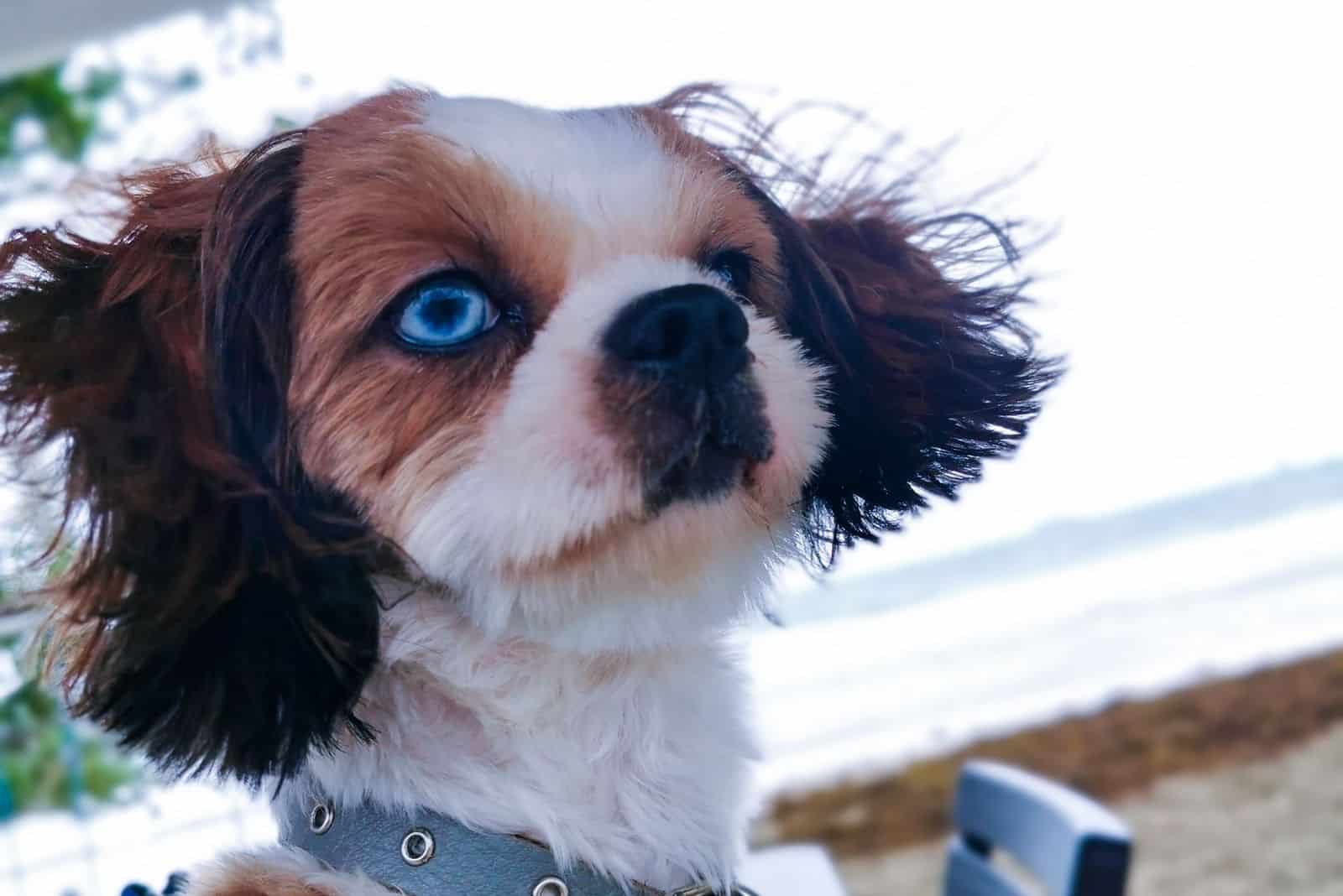
As you’ve probably figured by now, Shih Tzus are dogs that can come in plenty of different coat colors. However, their eyes will usually stay brown, and on very rare occasions, they will be green – such is the case with liver-colored dogs.
But, what about blue eyes?
The breed standard for the eye color in most dog breeds is usually solid black or brown. Anything lighter than that is usually the result of a dilute gene, and as such, it’s considered a genetic fault. This means that a Shih Tzu’s genetic pool will try to get rid of it.
For example, many liver dogs that do have some sort of a dilution gene will have lighter eye colors such as amber, bright brown, or even dark golden. The same goes with the color of their noses, foot pads, etc.
Blue Shih Tzus have blue/gray noses, lips, paw pads, and eye rims for that same reason. They are of that shade that appears blue under a certain light. However, their eyes are a somewhat different story.
First off, all Shih Tzu puppies are born with blue eyes. Once they are several weeks old and their mothers have stopped nursing them, their eyes will darken. Most of this time, though, the puppies will have their eyes closed, so you won’t be able to see the blues.
Very few adult Shih Tzu dogs get to keep their blue eye color, and almost all of them are blue Shih Tzus. However, this eye color will be dark, almost gray, and you might not even notice the blue shade in them.
Another cause of the blue-eyed Shih Tzu is the presence of the merle gene. This dilution gene creates mottled patches of color on both the coat and the skin, and it can lead to blue or odd colored eyes.
These dogs, however, have a specific coat color that is recognizable, and it looks nothing like other Shih Tzu colors.
Also, the AKC doesn’t recognize merle Shih Tzus. Quite the opposite; it condemns the purposeful breeding of merle dogs.
This is because the merle gene is connected with a plethora of health issues, including but not limited to hearing and vision problems, and cardiac and bone issues.
Double merles, which can be recognized by the white coat and blue eyes, are at an extreme risk of developing dangerous health conditions.
Should Blue Eyes Concern You?
The chances of your Shih Tzu puppy having blue eyes as an adult dog are very slim because this is such a rare color. However, if this does happen and the veterinarian doesn’t find anything wrong, it is perfectly fine.
However, if your pooch had brown eyes, but you have suddenly noticed that they’re turning cloudy or blue, this might be an indication of some health issue such as glaucoma or cataracts.
Another health problem that might cause your Shih Tzu’s eyes to gain a bluish hue is some kind of inflammation or even corneal ulcers.
Any sudden change in your dog’s pigmentation, whether that be in his eyes or coat, can be a sign of something dangerous, and you need to have it checked.
Blue Heeler Shih Tzu Mix

If you’re trying to find a blue Shih Tzu puppy online, you might get plenty of results that point you toward getting a Blue Heeler Shih Tzu. However, this is a crossbreed and not a purebred dog, which can be problematic for some people.
These dogs – also known as the Blue-Tzu Heeler – are the result of a mix between Shih Tzus and Australian Cattle Dogs. These companion pets are one of the more popular designer dogs that you can find online.
However, it is important to note that this isn’t a purebred Shih Tzu – in fact, it doesn’t even have to come in blue coat color. This is just a mixed breed that does have some increased chances of being blue.
A Blue Nosed Shih Tzu
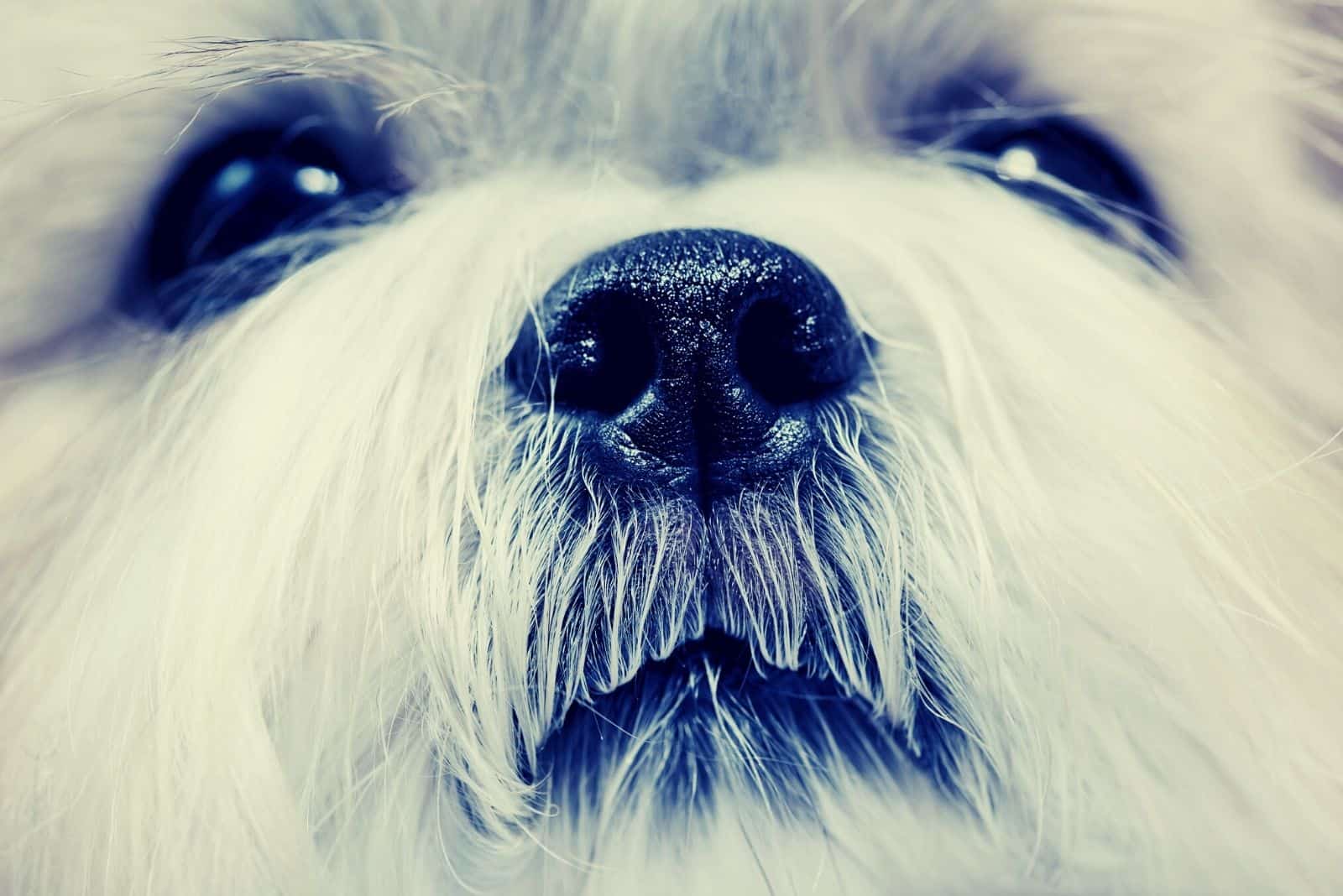
Plenty of Shih Tzu enthusiasts have heard about a blue nosed Shih Tzu, and they think that this is some new bloodline or breed, so they’ll look everywhere for a blue nosed puppy.
The truth is, a blue nosed Shih Tzu is just a regular blue Shih Tzu. All blue dogs have to have a blue nose. Otherwise, they’ll simply be considered diluted black or liver.
So, don’t let breeders fool you – a blue nosed Shih Tzu shouldn’t cost more than a regular blue dog as they are the same, no matter what they might tell you.
A Blue Shih Tzu Puppy
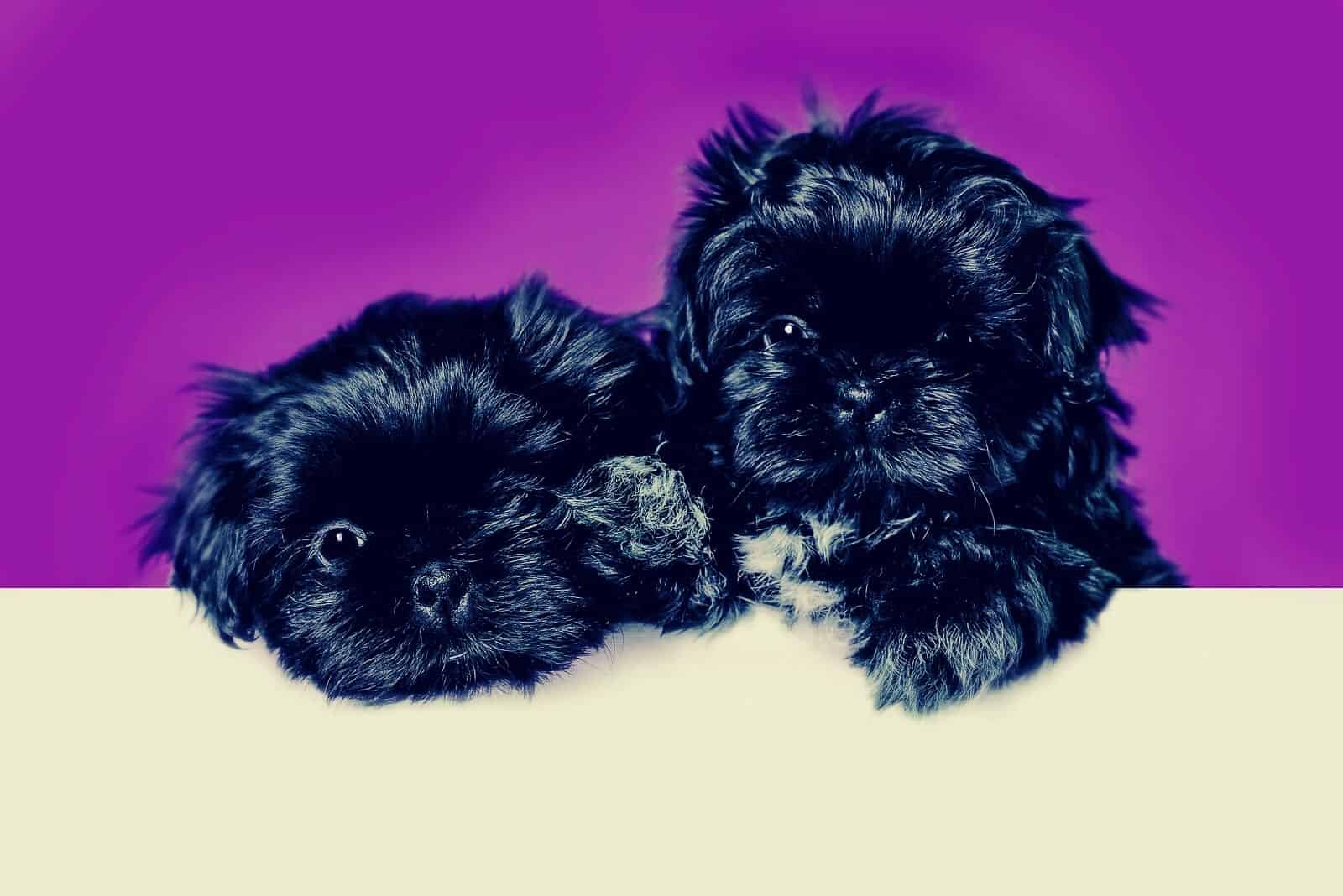
Blue Shih Tzu puppies aren’t different from any other Shih Tzu puppy other than they are somewhat rare. Not many Shih Tzu breeders sell blue Shih Tzu puppies.
Some unreputable breeders might even try to sell you a regular gray puppy as a blue Shih Tzu, but these pups aren’t the same as blue Shih Tzus.
For your blue Shih Tzu puppy to remain in that gorgeous blue coat color, you should feed it with high-quality dog food and ensure that he always gets proper nutrition.
You should also make sure that your pup gets plenty of exercise, but try not to let him spend too much time in the sun as this can make his coat become duller in color.
Blue Eyed Shih Tzu For Sale
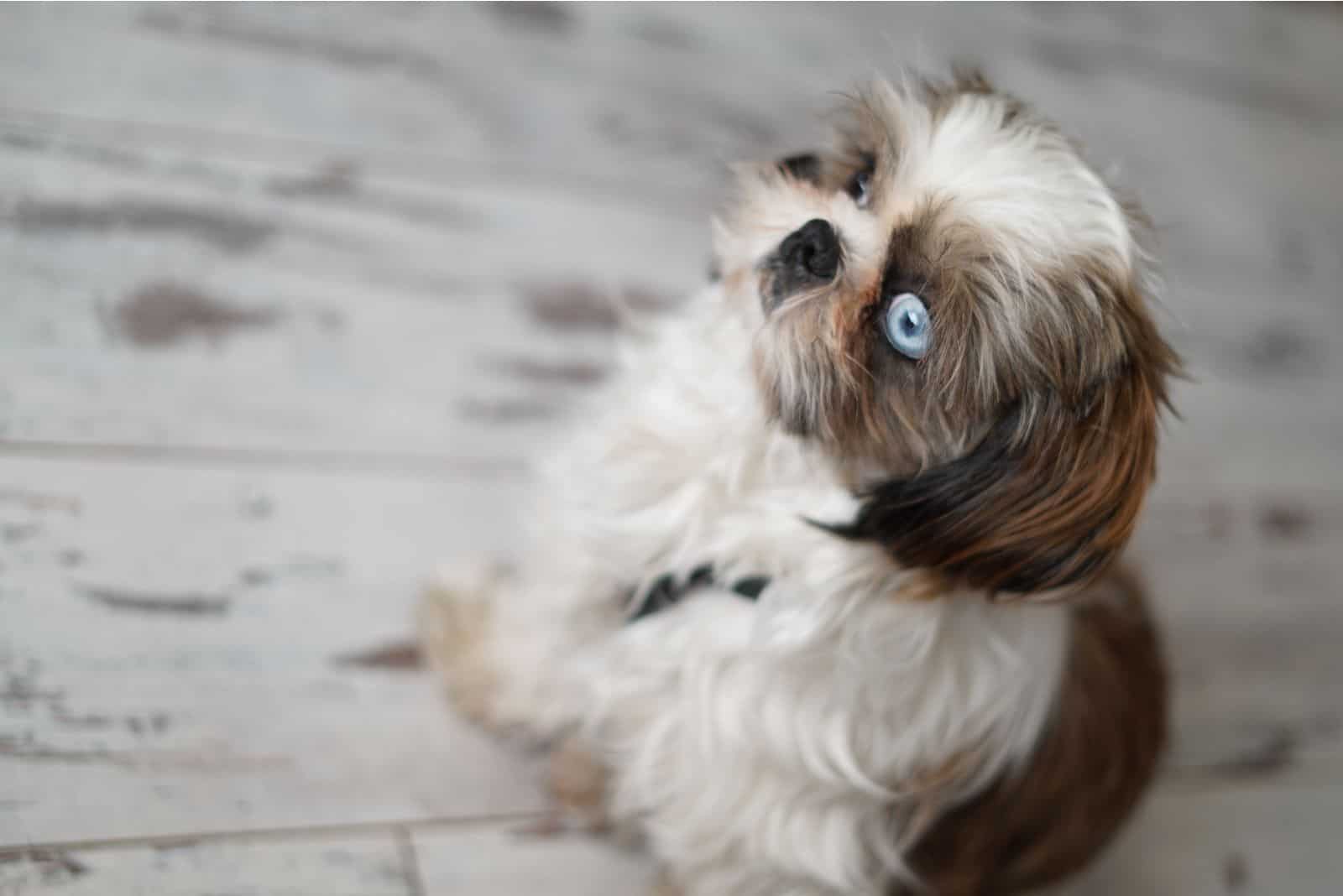
After reading all of this, you might want to get a hold of a blue Shih Tzu puppy. Chances are, you might even want a blue-eyed one!
To avoid any risks, you should always buy your dogs from reputable breeders. These people and companies do all they can to provide you with healthy dogs that are free of any genetic issues.
This is especially important if you plan on getting a blue-eyed blue merle Shih Tzu as there are some potential risks that come with a merle coat color.
If you aren’t certain about where to start, we’ll list a few reputable Shih Tzu breeders. All of them sell blue Shih Tzus, although no one can guarantee that you will get a blue-eyed dog.
Of course, there are plenty of other responsible Shih Tzu breeders out there, and you should always do your own research before you pay for a new pet.
And, if you wondered how much does a Shih Tzu cost, while the average Shih Tzu puppy price is between $500 and $1000, you can expect to pay a lot more for this rare feature.
Blue Cajun Shih Tzu
This dog breeder from South Louisiana sells Shih Tzus in rare coat colors – including blue. Many of their dogs have blue eyes, which makes them rather unique among breeders.
The AKC inspected and approved this breeder, so you can be certain that these dogs don’t carry faulty genes that can cause health problems.
All puppies are raised inside a family home, so they can adapt to apartment living from an early age. This means you can get yourself a well-behaved pup that won’t need too much training and socialization, which is always a plus.
Blue Heaven Shih Tzu
The Blue Heaven Shih Tzu breeder is located in New Carolina. Although not many of their puppies have blue eyes, they breed dogs in rare colors, and blue is one of them.
They ensure that all of their puppies are trained and properly socialized, so they don’t develop any problematic behavior later on.
All of their dogs are purebred, hypoallergenic, and according to Shih Tzu forums, they are the go-to choice of most local aspiring dog owners.
The Bluegrass Shih Tzu Rescue
If you’re longing to become a Shih Tzu owner, but you don’t feel like buying a dog is the right choice for you, then you might consider adopting. If you think finding a purebred dog that has been put up for adoption is difficult, you probably haven’t heard of organizations such as the Bluegrass Shih Tzu Rescue.
This rescue team doesn’t have a physical business location, but they specialize in finding homes for homeless, abused, and abducted small dog breeds.
What Is The Rarest Shih Tzu Color?
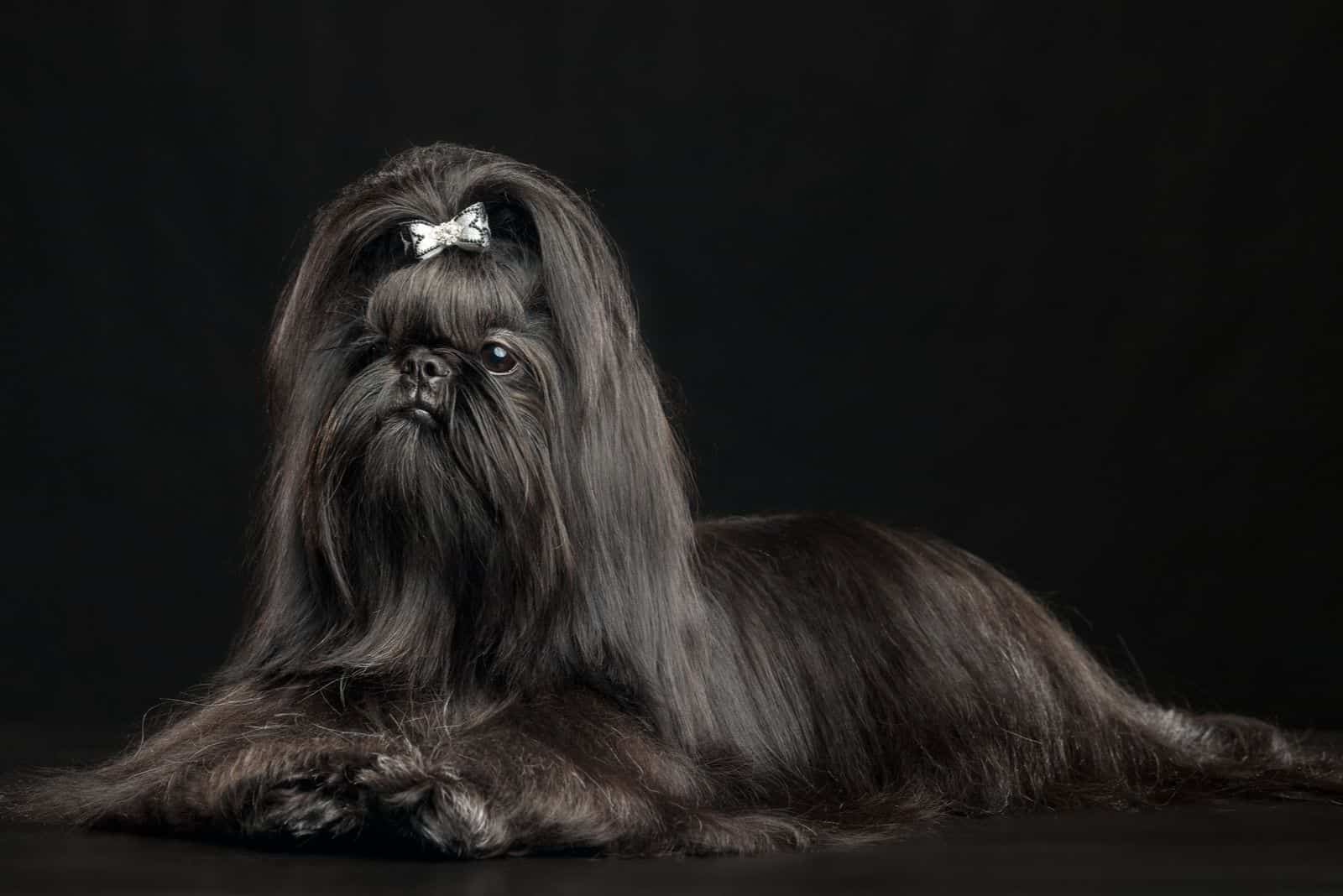
Now that we have talked about all the colors, you may wonder what the rarest Shih Tzu color is. While the breed comes in a huge range of different colors, not all of them are equally common.
Despite our focus being on the blue Shih Tzu, the rarest color of them all is a pure black Shih Tzu.
You can hardly ever find a Shih Tzu in pure black color. Most of them will have at least a single small white or tan marking somewhere on their body. No matter how difficult it might be to notice it, this alone is enough for a dog to no longer be considered single-colored.
Will Blue Shih Tzus Change Colors Over Time?
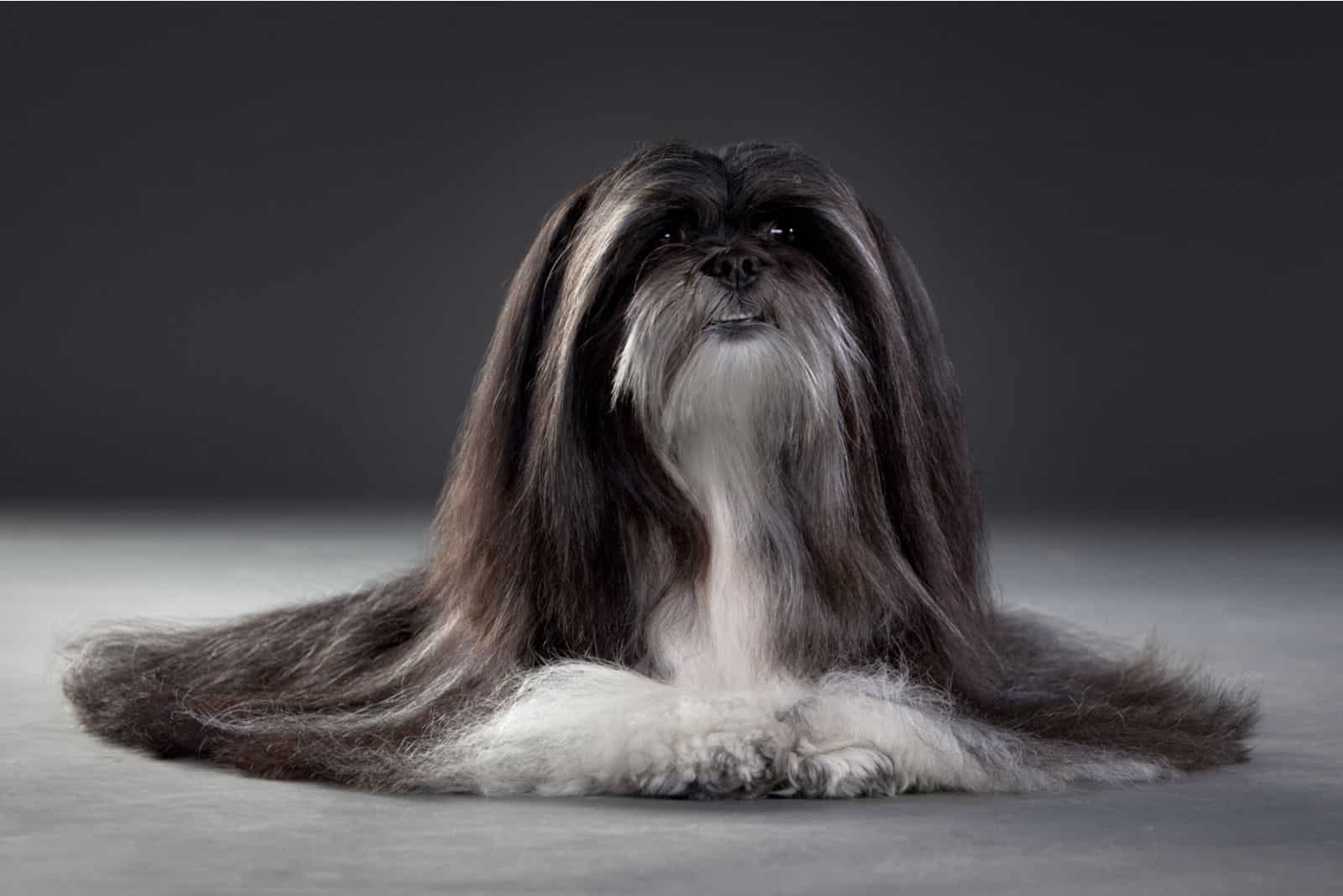
Shih Tzu coats have a unique characteristic, and that is that they can change color over time. Most coat colors will become lighter as time passes. Others might turn gray.
It isn’t uncommon that a puppy registered under one coat color changes shades entirely once they become adults.
Many Shih Tzu owners end up quite surprised by this as the coat color of their dog doesn’t end up being anything close to the color of the puppy they bought.
This is because Shih Tzus contain two genes that determine whether a dog’s coat will turn gray or fade over time, and despite some rumors, a dog’s gender doesn’t influence this. Whether it is a male vs. female Shih Tzu, it doesn’t really matter in this case. Both can experience this.
This is another reason why you should always look at a dog’s nose color if you want to know whether you have a blue Shih Tzu, a black one, a liver one, and so on. While the coat might change color, the nose will always remain the same.
Brindle puppies are most likely to change color over time, and some might even become solid colored. However, other coat colors can entirely change over time as well.
Fading
A specific ‘G’ gene is responsible for the fading of the coat color as the pup grows older. This can be noticed on dogs no older than a month!
In fact, it isn’t rare that a puppy that appeared black at birth becomes blue, gray, or sometimes even brown or red as an adult dog! This is why you should always look at a Shih Tzu’s nose if you want to be certain what shade your dog might have.
This fading will usually stop before the dog’s first birthday. At around this time, a Shih Tzu will reach its true adult color.
Keep in mind that the lighter the puppy’s color, the less chances of it fading. However, most dark-coated pups will change color at least a bit as they grow older.
Graying
Some dogs can become gray when they become adults. This is because of the so-called Chinchilla gene (CH series).
This isn’t the same as fading. In fact, it resembles graying in elderly dogs as the Shih Tzu’s coat turns a rich silver color.
This is common in blue Shih Tzus, and many will appear much older because of this genetic trait. It can affect lighter dogs as well.
Why Do We Love Blue Shih Tzus?
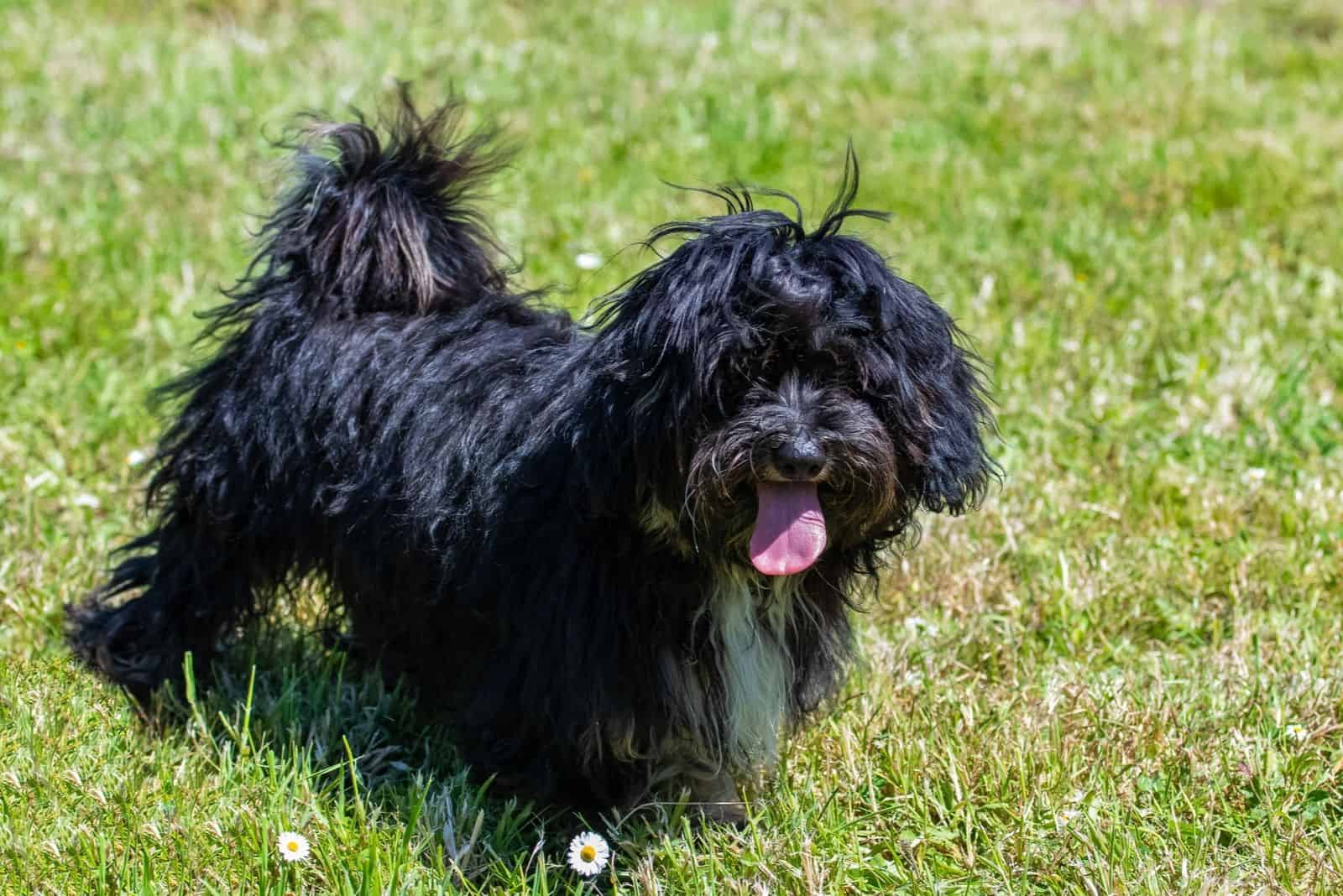
Blue Shih Tzus can be recognized by the color of their nose, and not just their coat. They can commonly be white, gray, silver, blue, or even cream and lavender! They can also have all sorts of markings, including brindle, mask, tuxedo, and others.
While Shih Tzus come in a big variety of colors, the blue shade is still one of the most popular when it comes to coat color. There are plenty of reasons behind this.
First off, blue Shih Tzus are somewhat rare. While not as rare as solid black Shih Tzus, they are still fairly uncommon. This is one of the factors that causes the price to skyrocket.
These pups can also have blue eyes; something that is very rare with this breed. They can have this without the merle gene, so they are a lot healthier compared to many other blue-eyed dogs.
While blue Shih Tzus tend to change color over time, they still remain gorgeous and unique looking. In fact, this is just another reason why many people love them – you can never know how your pup will end up looking!
And, did we mention just how gorgeous these dogs are? A blue nose looks cute with any coat color, and there is something truly special about this.
If you find the right breeder who will sell you a healthy, high-quality dog, you can rest assured that you have gotten yourself an adorable companion dog that doesn’t shed and that will stay by your side for many years to come.
Read Next: 19 Best Shih Tzu Breeders In Florida

